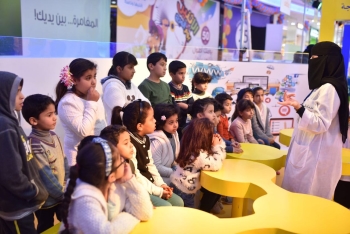SABIC’s 2016 Sustainability Report charts growth in projects with social, economic, and environmental benefit
26/04/2017
SABIC’s 2016 Sustainability Report, entitled Transforming Together, released at the Annual General Meeting, shows how SABIC is implementing projects all over the world that are resulting in financial returns for shareholders while helping to ensure the long-term safety and prosperity of communities.
The Sustainability Report 2016 can be downloaded at www.sabic.com/en/sustainability/corporate-reporting.
“This year’s Sustainability Report has been released together with our Annual Report for the first time because sustainability is a foundation of our strategy – spreading awareness of our efforts in this field and raising the bar for sustainability reporting in the region are priorities for SABIC,” said Yousef Al-Benyan, Vice-Chairman and CEO. “Integrating sustainability into our thinking has helped us to grow while increasing our benefit to society. This approach supports our 2025 strategy, contributes to Saudi Vision 2030, and ultimately spreads the benefits of ‘Chemistry that MattersTM’ to communities all over the world.”
The 2016 Sustainability Report provides in-depth information about SABIC’s sustainability in its 50 operating counties. The report covers innovation and sustainability solutions, resource and energy efficiency, EHSS and product safety, developing human capital, supply chain, and social impacts and community relationships. An independent auditor reviewed specified data in the report and accompanying text.
Innovation and sustainability solutions
SABIC continues a strong record in collaboration to produce fresh ideas in feedstock diversification, automotive design, downstream-industry development in Saudi Arabia, and solutions that enable customers to respond quickly to trends in dynamic and competitive markets.
Highlights include 10 new sustainability product solutions, which create less CO2 emissions than traditional materials during production or save more during their lifecycle, and verification of over 170 projects for sustainability benefits and risks. SABIC launched the Home of InnovationTM initiative to provide businesses with a forum for collaboration and promote downstream growth. In another key cooperation that could increase economic diversification and create thousands of jobs in Saudi Arabia, SABIC signed an agreement with Saudi Aramco to conduct a feasibility study on the development of a fully integrated crude oil-to-chemicals complex.
Resource and energy efficiency
SABIC continues to make progress on reducing greenhouse-gas, energy, and water intensities by 25 percent, and material-loss intensity by 50 percent from levels in 2010 by 2025. Since 2010, SABIC has reduced material loss intensity by 41 percent, greenhouse-gas emissions intensity has fallen 8.3 percent, energy intensity 6 percent, and water intensity 10.4 percent. Flaring has been reduced by 55 percent.
The first full year of operations at two major projects at the SAFCO and United manufacturing affiliates boosted resource efficiency, with 3.6 million metric tons of CO2 utilized as feedstock throughout the year.
To support these efforts, SABIC established a global Energy Policy that ensures the availability of reliable and cost-effective energy, and a commitment to continuous efficiency improvement and design.
EHSS and Product Safety
To drive improvement in performance, SABIC critically reviewed its environment, health, safety, and security organization, changing from a regional-based structure to a global structure with regional support. The company achieved an EHSS incident rate of 0.62, some 29 percent lower than last year; a 13 percent reduction in the total number of minor and higher incidents that influence the rate, though overall severity increased; and 21 less hazardous-substance chemical-release incidents.
Developing human capital
To support SABIC’s 2025 strategy, the organization has become more agile while accelerating sustainable growth and focusing on customer needs. Attracting and retaining passionate employees who share this commitment is part of this change, as is a culture of diversity, inclusion, and collaboration. Throughout 2016, SABIC continued to invest in learning and development for skills, cross-functional expertise, and senior leadership capabilities – providing continuous learning and rewarding the best performers.
SABIC has over 35,000 employees, 64 percent based in the Middle East and Africa, 14 percent in Europe, 14 percent in Europe, and 8 percent in Asia. SABIC trained 1,800 managers and executives and ran 4,200 learning and development programs, and some 31,000 benefited from training programs.
Supply Chain
SABIC’s complex supply chain, with close to 20,000 delivery locations spanning 140 countries, experienced an extremely safe year with zero major incidents. The company made critical progress on emissions-reduction initiatives, including developing a new generation of eco-friendly vessels; established a Supply Chain Academy to strengthen core supply-chain competencies; and implemented four additional metrics in the Supply Chain and Procurement Sustainability Initiative. These practices will result in energy savings, improved resource efficiency, technological innovation, and cost savings.
Social Impacts and Community Relationships
In 2016, SABIC implemented its RASIE corporate and social responsibility strategy globally, enabling employee volunteers to nominate CSR activities for consideration by regional committees. The committees reviewed nearly 400 ideas, approving over 50 percent based on their alignment with the strategy, which focuses on four areas: Science and Technology Education, Environmental Protection, Health and Wellness, and Water and Sustainable Agriculture. To encourage participation, employees were offered eight hours of paid leave to volunteer for their favoured programs every year.
Throughout the year, SABIC spent US$46.4 million on community giving, bringing the total level over the past 15 years to $800 million.
ENDS
Hisham Al-Joher
Director, Global Media

